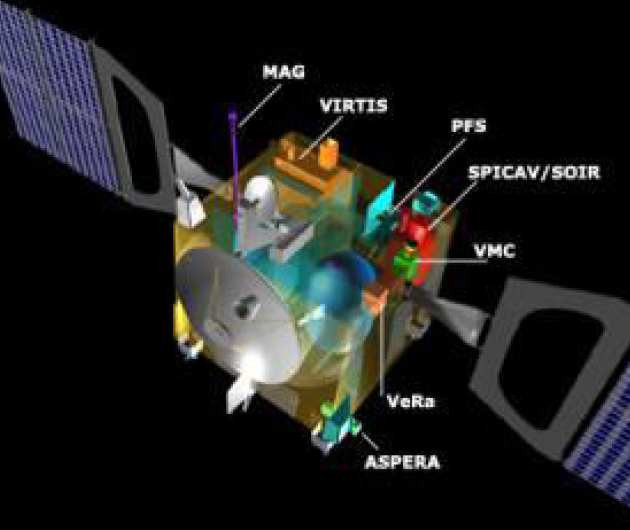Venus Express is the first European Space Agency (ESA) mission to visit Earth's nearest planetary neighbour.
Mission Summary
 Image shows an Artists's Impression of the Spacecraft at Venus (picture credit: ESA)
Image shows an Artists's Impression of the Spacecraft at Venus (picture credit: ESA)
The mission was selected in 2001 from a number of different proposals, all of which copied the design of the Mars Express spacecraft. In doing so, ESA was able to build Venus Express in a very short time, at a relatively low cost, and use many of the science instrument designs developed for Mars Express or the Rosetta mission. The spacecraft was launched in November 2005.
Venus is often referred to as the Earth's twin. It is our nearest planetary neighbour, it is of similar size and mass, and made from the same basic material when the solar system formed 4.5 billion years ago. However, Earth and Venus have evolved in markedly different ways. The surface temperature at Venus can be nearly 500 degrees Centigrade, and the atmosphere is 96% Carbon-dioxide with clouds of Sulphuric acid.
Imperial College participation in the Venus Express mission was funded by the UK Science & Technology Facilities Council until 2011.
Venus Express
- Venus Express Fact Overview
- External Links
- Mission Objectives
- Magnetometer Instrument
- The Magnetometer Team
- Supporting Investigator
Useful Links
Venus Express Links:
 At Imperial, we are interested in the upper atmosphere, the ionosphere, and the interaction of these regions with the solar wind, the million mile-per-hour stream of ionising radiation that flows outwards from the Sun. A consortium of three institutes, including Imperial, built the magnetometer instrument that measures the magnetic field around Venus. This information is being used to identify boundaries between different regions of plasma and investigate the way plasmas, originating from the solar wind or the planetary atmosphere, combine and mix. Through our hardware involvement, Imperial College holds Co-Investigator status on the magnetometer instrument (
At Imperial, we are interested in the upper atmosphere, the ionosphere, and the interaction of these regions with the solar wind, the million mile-per-hour stream of ionising radiation that flows outwards from the Sun. A consortium of three institutes, including Imperial, built the magnetometer instrument that measures the magnetic field around Venus. This information is being used to identify boundaries between different regions of plasma and investigate the way plasmas, originating from the solar wind or the planetary atmosphere, combine and mix. Through our hardware involvement, Imperial College holds Co-Investigator status on the magnetometer instrument ( The MAG (magnetometer) instrument is investigating the Venus plasma environment. Dr. Tielong Zhang at The Space Research Institute (
The MAG (magnetometer) instrument is investigating the Venus plasma environment. Dr. Tielong Zhang at The Space Research Institute (
 Under the leadership of
Under the leadership of